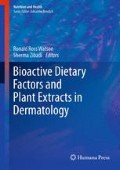Abstract
Withania somnifera (W. somnifera) is popularly known as Ashwagandha. It is a herbal drug from the Indian system of medicine. W. somnifera is an official drug mentioned in the Indian Pharmacopoeia. Of all parts of this plant, the root has been considered to be the most active for therapeutic purposes. The major pharmacological activity of the plant is attributed to the presence of several alkaloids and withaniols. Roots are prescribed in medicines for hiccup, several female disorders, bronchitis, rheumatism, dropsy, stomach and lung inflammations and skin diseases. W. somnifera was found to be effective in prevention of skin carcinoma in UV B radiation-exposed animals, DMBA-induced carcinogenesis and in long-term tumorigenesis. A toxicological study showed that W. somnifera is nontoxic in a wide range of reasonable doses.
Access this chapter
Tax calculation will be finalised at checkout
Purchases are for personal use only
References
Kapoor VK, Dureja J, Chadha R. Herbals in the control of ageing. Drug Discov Today. 2009;14:992–8. doi:10.1016/j.drudis.2009.06.014.
Davis L, Kuttan G. Immunomodulatory activity of Withania somnifera. J Ethnopharmacol. 2000;71:193–200.
Joy PP, Thomas J, Mathew S, Skaria BP. Medicinal plants. In: Bose TK, Das KP, Joy PP, editors. Tropical horticulture, vol. 2. Calcutta: Naya Prokash; 2001. p. 54–5.
Nadkarni AK. In: Indian Materia Medica. 3rd ed. Volume 1. Bombay: Popular Book Depot; 1987. p. 1292–1294.
Buddhiraja RD, Sudhir S. Review of biological activity of withanolides. J Sci Ind Res. 1987;46:488–91.
Rasool M, Varalakshmi P. Immunomodulatory role of Withania somnifera root powder on experimental induced inflammation: an in vivo and in vitro study. Vascul Pharmacol. 2006;44:406–10.
Davis L, Kuttan G. Effect of Withania somnifera on DMBA induced carcinogenesis. J Ethnopharmacol. 2001;75:165–8.
Hamza A, Amin A, Daoud S. The protective effect of a purified extract of Withania somnifera against doxorubicin-induced cardiac toxicity in rats. Cell Biol Toxicol. 2008;24:63–73.
Mathur S, Kaur P, Sharma M, Katyal A, Singh B, Tiwari M, Chandra R. The treatment of skin carcinoma, induced by UV B radiation, using 1-oxo-5beta, 6beta-epoxy-witha-2-enolide, isolated from the roots of Withania somnifera, in a rat model. Phytomedicine. 2004;11:452–6.
Prakash J, Gupta SK, Dinda AK. Withania somnifera root extract prevents DMBA-induced squamous cell carcinoma of skin in Swiss albino mice. Nutr Cancer. 2002;42:91–7.
Padmavathi B, Rath PC, Rao AR, Singh RP. Roots of Withania somnifera inhibit forestomach and skin carcinogenesis in mice. Evid Based Complement Alternat Med. 2005;2:99–105.
Aphale AA, Chhibba AD, Kumbhakarna NR, Mateenuddin M, Dahat SH. Subacute toxicity study of the combination of ginseng (Panax ginseng) and ashwagandha (Withania somnifera) in rats: a safety assessment. Indian J Physiol Pharmacol. 1998;42:299–302.
Dahanukar SA, Kulkarni RA, Rege NN. Pharmacology of medicinal plants and natural products. Indian J Pharmacol. 2000;32:S81–118.
Monograph Withania somnifera. Alternative medicine review, Thorne Research, Inc. 2004;9(2):211–14. http://www.thorne.com/altmedrev/.fulltext/9/2/211.pdf.
Author information
Authors and Affiliations
Corresponding author
Editor information
Editors and Affiliations
Rights and permissions
Copyright information
© 2013 Springer Science+Business Media New York
About this chapter
Cite this chapter
Zanwar, A.A., Badole, S.L., Saini, R. (2013). Withania somnifera: Use for Skin Disease. In: Watson, R., Zibadi, S. (eds) Bioactive Dietary Factors and Plant Extracts in Dermatology. Nutrition and Health. Humana Press, Totowa, NJ. https://doi.org/10.1007/978-1-62703-167-7_47
Download citation
DOI: https://doi.org/10.1007/978-1-62703-167-7_47
Published:
Publisher Name: Humana Press, Totowa, NJ
Print ISBN: 978-1-62703-166-0
Online ISBN: 978-1-62703-167-7
eBook Packages: MedicineMedicine (R0)

